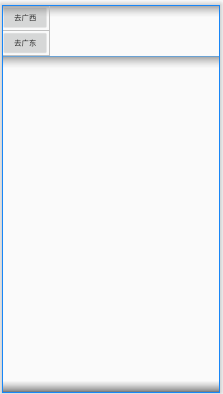Android studio 动态fragment的使用方法?很多新手对此不是很清楚,为了帮助大家解决这个难题,下面小编将为大家详细讲解,有这方面需求的人可以来学习下,希望你能有所收获。
fragment的使用时Android的基础,它有两种用法,第一个就是静态的fragment。第二个则是动态的fragment。
静态fragment直接在layout创建你想要的fragment的XML的文件,然后在你的Java包里面创建对应fragment的class文件
布局代码如下所示

<?xml version="1.0" encoding="utf-8"?>
<LinearLayout xmlns:android="http://schemas.android.com/apk/res/android"
android:layout_width="match_parent"
android:layout_height="match_parent"
android:orientation="vertical">
<TextView
android:layout_width="match_parent"
android:layout_height="wrap_content"
android:text="欢迎来到广西!"/>
</LinearLayout>
<?xml version="1.0" encoding="utf-8"?>
<LinearLayout xmlns:android="http://schemas.android.com/apk/res/android"
xmlns:app="http://schemas.android.com/apk/res-auto"
xmlns:tools="http://schemas.android.com/tools"
android:layout_width="match_parent"
android:layout_height="match_parent"
android:orientation="vertical"
tools:context=".MainActivity">
<Button
android:layout_width="wrap_content"
android:layout_height="wrap_content"
android:text="去广西"
android:id="@+id/bt_anjian1"/>
<Button
android:layout_width="wrap_content"
android:layout_height="wrap_content"
android:text="去广东"
android:id="@+id/bt_anjian2"/>
<LinearLayout
android:layout_width="match_parent"
android:layout_height="wrap_content"
android:orientation="vertical"
android:id="@+id/ll_rongqi"
android:layout_weight="9">
</LinearLayout>
<fragment
android:layout_width="wrap_content"
android:layout_height="wrap_content"
android:id="@+id/fragment_1"/>
</LinearLayout>*这里需要注意一下,如果你不给fragment加个id,那你运行app的时候将会发生闪退现象。

package com.example.anyone_fragment_2;
import android.os.Bundle;
import android.view.LayoutInflater;
import android.view.View;
import android.view.ViewGroup;
import android.widget.Button;
import androidx.annotation.NonNull;
import androidx.annotation.Nullable;
import androidx.fragment.app.Fragment;
public class Fragment_1 extends Fragment {
@Nullable
@Override
public View onCreateView(@NonNull LayoutInflater inflater, @Nullable ViewGroup container, @Nullable Bundle savedInstanceState) {
View view=inflater.inflate(R.layout.fragment_1,container,false);
return view;
}
}这样静态fragment算是弄好了,但是这次我们主要讨论动态fragment的用法
首先,我们先在activity_main中写下如下代码
<?xml version="1.0" encoding="utf-8"?>
<LinearLayout xmlns:android="http://schemas.android.com/apk/res/android"
xmlns:app="http://schemas.android.com/apk/res-auto"
xmlns:tools="http://schemas.android.com/tools"
android:layout_width="match_parent"
android:layout_height="match_parent"
android:orientation="vertical"
tools:context=".MainActivity">
<Button
android:layout_width="wrap_content"
android:layout_height="wrap_content"
android:text="去广西"
android:id="@+id/bt_anjian1"/>
<Button
android:layout_width="wrap_content"
android:layout_height="wrap_content"
android:text="去广东"
android:id="@+id/bt_anjian2"/>
<LinearLayout
android:layout_width="match_parent"
android:layout_height="wrap_content"
android:orientation="vertical"
android:id="@+id/ll_rongqi"
android:layout_weight="9">
</LinearLayout>
</LinearLayout>布局效果图是这样的

这里fragment的XML文件和开头所说的静态fragment的那个XML文件的写法是一样的
同理,fragment对应的class文件也是相同的。
package com.example.anyone_fragment_2;
import androidx.appcompat.app.AppCompatActivity;
import androidx.fragment.app.Fragment;
import androidx.fragment.app.FragmentManager;
import androidx.fragment.app.FragmentTransaction;
import android.os.Bundle;
import android.view.View;
import android.widget.Button;
public class MainActivity extends AppCompatActivity implements View.OnClickListener {//有abstract就闪退
private Button bt_anjian1,bt_anjian2;
private Fragment Fragment_1,Fragmentnow,Fragment_2;
private FragmentManager fragmentManager;
private FragmentTransaction fragmentTransaction;
@Override
protected void onCreate(Bundle savedInstanceState) {
super.onCreate(savedInstanceState);
setContentView(R.layout.activity_main);
chushihua();
shilihua();
}
private void chushihua()
{
bt_anjian1=findViewById(R.id.bt_anjian1);
bt_anjian2=findViewById(R.id.bt_anjian2);
bt_anjian1.setOnClickListener(this);
bt_anjian2.setOnClickListener(this);
}
private void shilihua(){
//用于实例化fragment
Fragment_1=new Fragment_1();
Fragment_2=new Fragment_2();
Fragmentnow=Fragment_1;
fragmentManager=getSupportFragmentManager();
fragmentTransaction=fragmentManager.beginTransaction();
//38:只要你要对fragment进行操作就少不了这句 原来的写法是FragmentTransaction fragmentTransaction=fragmentManager.beginTransaction();
fragmentTransaction.add(R.id.ll_rongqi,Fragment_1).commit();
}
public void onClick(View vv)
{
fragmentTransaction=fragmentManager.beginTransaction();
switch (vv.getId())
{
case R.id.bt_anjian1:if (Fragment_1.isAdded())
{
fragmentTransaction.hide(Fragmentnow).show(Fragment_1).commit();
}
else
{
fragmentTransaction.hide(Fragmentnow).add(R.id.ll_rongqi,Fragment_1).commit();
}
Fragmentnow=Fragment_1;
break;
case R.id.bt_anjian2:if(Fragment_2.isAdded())
{
fragmentTransaction.hide(Fragmentnow).show(Fragment_2).commit();
}
else
{
fragmentTransaction.hide(Fragmentnow).add(R.id.ll_rongqi,Fragment_2).commit();
}
Fragmentnow=Fragment_2;
break;
}
}
}下面来分析一些地方
初始化功能函数
private void chushihua()
{
bt_anjian1=findViewById(R.id.bt_anjian1);
bt_anjian2=findViewById(R.id.bt_anjian2);
bt_anjian1.setOnClickListener(this);
bt_anjian2.setOnClickListener(this);
}这样写的目的是让代码可读性更好,不至于很混乱。
其次就是实例化我们所写的fragment功能函数
private void shilihua(){
//用于实例化fragment
Fragment_1=new Fragment_1();
Fragment_2=new Fragment_2();
Fragmentnow=Fragment_1;
fragmentManager=getSupportFragmentManager();
fragmentTransaction=fragmentManager.beginTransaction();
//38:只要你要对fragment进行操作就少不了这句 原来的写法是FragmentTransaction fragmentTransaction=fragmentManager.beginTransaction();
fragmentTransaction.add(R.id.ll_rongqi,Fragment_1).commit();
}其中的
FragmentManager fragmentManager;
这个是fragment和activity交互所要用到的。
fragmentManager=getSupportFragmentManager();固定写法。
而
private FragmentTransaction fragmentTransaction;
fragmentTransaction=fragmentManager.beginTransaction();是调动fragment操作的API,也必不可少。
fragmentTransaction.add(R.id.ll_rongqi,Fragment_1).commit();是添加fragment所用的语句,在这里就相当于是初始化吧。add(容器id,碎片对象),commit则是提交。
public void onClick(View vv)
{
fragmentTransaction=fragmentManager.beginTransaction();
switch (vv.getId())
{
case R.id.bt_anjian1:if (Fragment_1.isAdded())
{
fragmentTransaction.hide(Fragmentnow).show(Fragment_1).commit();
}
else
{
fragmentTransaction.hide(Fragmentnow).add(R.id.ll_rongqi,Fragment_1).commit();
}
Fragmentnow=Fragment_1;
break;
case R.id.bt_anjian2:if(Fragment_2.isAdded())
{
fragmentTransaction.hide(Fragmentnow).show(Fragment_2).commit();
}
else
{
fragmentTransaction.hide(Fragmentnow).add(R.id.ll_rongqi,Fragment_2).commit();
}
Fragmentnow=Fragment_2;
break;
}
}这里的onClick的名字是不能改变的,否则你button没办法触发。
用传来的形参View vv来获取到我们所点击的按钮来判断操作。
思想就是,如果Fragment存在,则只需要把它展示出来即可。isAdded嘛,ed过去式,那就是代表存在过咯。
若是没有,则添加就好。
看完上述内容是否对您有帮助呢?如果还想对相关知识有进一步的了解或阅读更多相关文章,请关注亿速云行业资讯频道,感谢您对亿速云的支持。
亿速云「云服务器」,即开即用、新一代英特尔至强铂金CPU、三副本存储NVMe SSD云盘,价格低至29元/月。点击查看>>
免责声明:本站发布的内容(图片、视频和文字)以原创、转载和分享为主,文章观点不代表本网站立场,如果涉及侵权请联系站长邮箱:is@yisu.com进行举报,并提供相关证据,一经查实,将立刻删除涉嫌侵权内容。